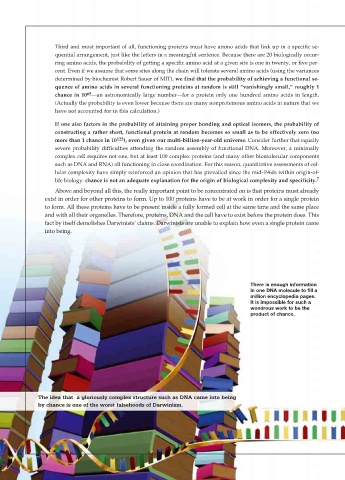Page 760 - Atlas of Creation Volume 4
P. 760
Third and most important of all, functioning proteins must have amino acids that link up in a specific se-
quential arrangement, just like the letters in a meaningful sentence. Because there are 20 biologically occur-
ring amino acids, the probability of getting a specific amino acid at a given site is one in twenty, or five per-
cent. Even if we assume that some sites along the chain will tolerate several amino acids (using the variances
determined by biochemist Robert Sauer of MIT), we find that the probability of achieving a functional se-
quence of amino acids in several functioning proteins at random is still “vanishingly small,” roughly 1
65
chance in 10 —an astronomically large number—for a protein only one hundred amino acids in length.
(Actually the probability is even lower because there are many nonproteinous amino acids in nature that we
have not accounted for in this calculation.)
If one also factors in the probability of attaining proper bonding and optical isomers, the probability of
constructing a rather short, functional protein at random becomes so small as to be effectively zero (no
more than 1 chance in 10 125 ), even given our multi-billion-year-old universe. Consider further that equally
severe probability difficulties attending the random assembly of functional DNA. Moreover, a minimally
complex cell requires not one, but at least 100 complex proteins (and many other biomolecular components
such as DNA and RNA) all functioning in close coordination. For this reason, quantitative assessments of cel-
lular complexity have simply reinforced an opinion that has prevailed since the mid-1960s within origin-of-
life biology: chance is not an adequate explanation for the origin of biological complexity and specificity. 7
Above and beyond all this, the really important point to be concentrated on is that proteins must already
exist in order for other proteins to form. Up to 100 proteins have to be at work in order for a single protein
to form. All these proteins have to be present inside a fully formed cell at the same time and the same place
and with all their organelles. Therefore, proteins, DNA and the cell have to exist before the protein does. This
fact by itself demolishes Darwinists’ claims. Darwinists are unable to explain how even a single protein came
into being.
There is enough information
in one DNA molecule to fill a
million encyclopedia pages.
It is impossible for such a
wondrous work to be the
product of chance.
The idea that a gloriously complex structure such as DNA came into being
by chance is one of the worst falsehoods of Darwinism.

